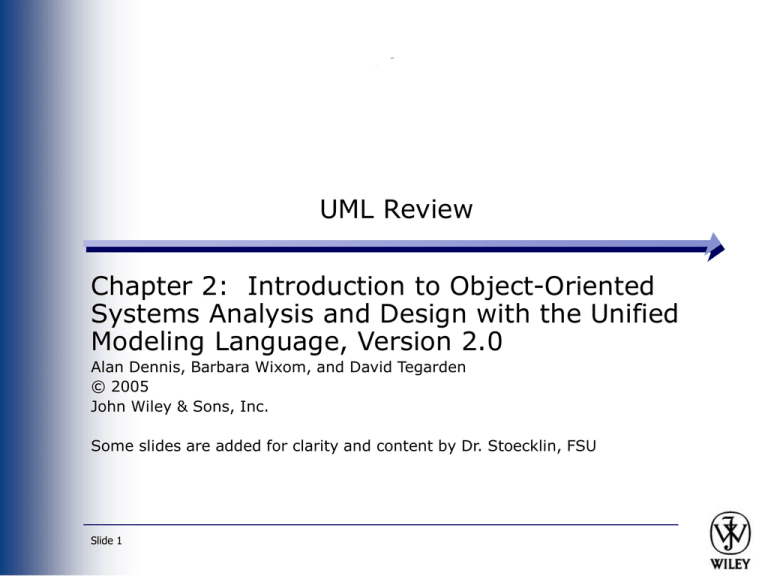
UML Review
Chapter 2: Introduction to Object-Oriented
Systems Analysis and Design with the Unified
Modeling Language, Version 2.0
Alan Dennis, Barbara Wixom, and David Tegarden
© 2005
John Wiley & Sons, Inc.
Some slides are added for clarity and content by Dr. Stoecklin, FSU
Slide 1
Copyright © 2005
John Wiley & Sons, Inc.
All rights reserved. Reproduction or translation of this
work beyond that permitted in Section 117 of the 1976
United States Copyright Act without the express written
permission of the copyright owner is unlawful.
Request for further information should be addressed to
the Permissions Department, John Wiley & Sons, Inc.
The purchaser may make back-up copies for his/her own
use only and not for redistribution or resale.
The Publisher assumes no responsibility for errors,
omissions, or damages, caused by the use of these
programs or from the use of the information contained
herein.
Slide 2
Unified Modeling Language,
Version 2.0
Chapter 2
Slide 3
Basic Characteristics of
Object Oriented Systems
Classes and Objects
Methods and Messages
Encapsulation and Information
Hiding
Inheritance
Polymorphism and Dynamic
Binding
Slide 4
Classes and Objects
Class – Template to define
specific instances or objects
Object – Instantiation of a class
Attributes – Describes the
object
Behaviors – specify what object
can do
Slide 5
Classes and Objects
Slide 6
Methods and Messages
Methods implement an object’s
behavior
Analogous to a function or
procedure
Messages are sent to trigger
methods
Procedure call from one object to
the next
Slide 7
Polymorphism and Dynamic
Binding
Polymorphism
A message can be interpreted
differently by different classes of
objects
Dynamic Binding
Sometimes called late binding
Delays typing or choosing a method for
an object until run-time
Static Binding
Type of object determined at compile
time
Slide 8
Polymorphish & Encapsulation
Slide 9
The Unified Modeling
Language, Version 2.0
Structure Diagrams
Behavior Diagrams
Extension Mechanisms
Developers
Grady Booch
Ivar Jacobson
James Rumbaugh
Slide 10
Structure Diagram
Structure Diagrams include
Class
Object
package
Deployment
Component
Composite structure diagrams
Slide 11
UML 2.0 Diagram Summary
Slide 12
Structure Diagrams
Class
relationship between classes
Object
Relationships between objects
Package
Group UML elements together to
form higher level constructs
Slide 13
Structure Diagrams Cont.
Deployment
Shows the physical architecture and
software components of system
Component
Physical relationships among software
components
Composite Structure
Illustrates internal structure of a class
Slide 14
Activity Diagrams
Activity
Illustrates business workflows
Sequence
Time-based ordering Behavior of objects
activities in a use case
Communication
Communication among a set of collaborating
objects of an activity
Interaction Overview Timing
Overview of flow of control of a process
Slide 15
State Machines
Behavioral State Machine
Examines behavior of one class
Protocol State Machine
Shows dependencies of different
interfaces of a class
Use-Case
Captures business requirements
Illustrates interaction between system
and environment
Slide 16
Use Case Diagrams
Captures Business requirements
Illustrates interaction between a
system and its environment
Includes end user
Any external system that interacts with
its information system
Documents and clarifies
requirements of system being
modeled
Slide 17
UML Summary
Class and method design
Data management layer design
Human computer interaction layer
design
Physical architecture layer design
Construction
Installation
Operations and support
Slide 18








